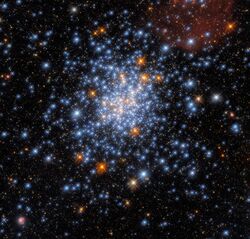Astronomy:NGC 330
| NGC 330 | |
|---|---|
 The star cluster NGC 330 Credit: Hubble Space Telescope | |
| Observation data (J2000 epoch) | |
| Constellation | Tucana |
| Right ascension | 00h 56m 17.6s[1] |
| Declination | −72° 27′ 47″[1] |
| Distance | 182000[1] |
| Apparent magnitude (V) | 9.60[2] |
| Apparent dimensions (V) | 2.8′ × 2.5′[3] |
| Physical characteristics | |
| Mass | 5.4×104[2] M☉ |
| Estimated age | 0.04±0.00 Gyr[2] |
| Other designations | ESO 029-SC 024.[1] |
NGC 330 is an open cluster in the Small Magellanic Cloud. It is located in the constellation Tucana. It was discovered on 1 August 1826 by James Dunlop. It was described by Dreyer as "a globular cluster, very bright, small, a little extended, stars from 13th to 15th magnitude."[4] At an aperture of 31.0 arcseconds, the apparent V-band magnitude is 9.60, but at this wavelength, it also has 0.36 magnitudes of interstellar extinction.[2]
NGC 330 is quite young, at about 40 million years old, and has a large proportion of Be stars.[5] Its estimated mass is 5.4×104 M☉, and its total luminosity is 8.93×105 L☉, leading to a mass-to-luminosity ratio of 0.06 M☉/L☉.[2] All else equal, older star clusters have higher mass-to-luminosity ratios; that is, they have lower luminosities for the same mass.[2] About 34% of the massive star population in NGC 330 is estimated to be in a close binary star system; this is lower than clusters in the Large Magellanic Cloud and the Milky Way, but it is unknown if this is because NGC 330 is metal-poor or is older than the compared clusters.[5]
References
- ↑ 1.0 1.1 1.2 1.3 "NASA/IPAC Extragalactic Database". Results for NGC 0330. http://ned.ipac.caltech.edu/cgi-bin/objsearch?objname=NGC+330&extend=no&hconst=73&omegam=0.27&omegav=0.73&corr_z=1&out_csys=Equatorial&out_equinox=J2000.0&obj_sort=RA+or+Longitude&of=pre_text&zv_breaker=30000.0&list_limit=5&img_stamp=YES.
- ↑ 2.0 2.1 2.2 2.3 2.4 2.5 Song, Ying-Yi; Mateo, Mario; Bailey, John I.; Walker, Matthew G.; Roederer, Ian U.; Olszewski, Edward W.; Reiter, Megan; Kremin, Anthony (2021). "Dynamical masses and mass-to-light ratios of resolved massive star clusters – II. Results for 26 star clusters in the Magellanic Clouds". Monthly Notices of the Royal Astronomical Society 504 (3): 4160–4191. doi:10.1093/mnras/stab1065.
- ↑ "NGC 330". SIMBAD. Centre de données astronomiques de Strasbourg. http://simbad.u-strasbg.fr/simbad/sim-basic?Ident=NGC+330.
- ↑ "New General Catalog Objects: NGC 300 - 349". Cseligman. http://cseligman.com/text/atlas/ngc3.htm#330.
- ↑ 5.0 5.1 Bodensteiner, J.; Sana, H.; Wang, C.; Langer, N.; Mahy, L.; Banyard, G.; de Koter, A.; de Mink, S. E. et al. (2021). "The young massive SMC cluster NGC 330 seen by MUSE. II. Multiplicity properties of the massive-star population". Astronomy & Astrophysics 652: 18. doi:10.1051/0004-6361/202140507. A70. Bibcode: 2021A&A...652A..70B.
External links
 |

